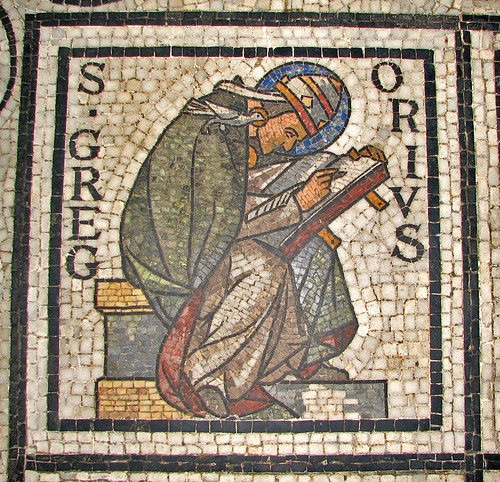What we sing.
We sing the 'proper' chants of the Mass: Introit, Gradual, Alleluia (in Lent, the Tract), the Offertory and the Communion. Graduals and, especially, Lenten Tracts can be quite long, but these are basically short pieces. (The longest Tract in the repertoire takes about 12 minutes to sing; 2-5 minutes would be more typical for a proper chant.) They vary in complexity, some being very complex indeed. As we sing them, a schola of between 4 and 10 singers is led by one or two cantors. Typically the cantors will sing the first word or two of a chant, and the 'verses' which alternate with the 'antiphon'. The 'propers' are so called because they are specific ('proper') to a particular Mass: they are different for each feast (though different feast sometimes share a particular proper, or even a set of propers).
The 'ordinary' chants of the Mass are the Kyrie, Gloria, Credo, Agnus Dei, Sanctus, and various short responses. Apart from the short responses these can be sung to polyphonic settings, and sometimes are so sung at our Masses. These pieces are what you will usually hear in recordings of polyphonic composers doing a Mass. When they are sung to chant settings, they are simple enough to allow the congregation to join in, usually in alternation with the schola. There are about 20 sets of propers in the most commonly used chant books, of which a handful are sung regularly.
 |
| St Gregory the Great. Photo by Br Lawrence: click through for more info. |
The Gregorian Chant tradition goes back to the chants used in the liturgy of the Temple in Jerusalem in antiquity. This tradition was developed in both the Christian East, and the Latin West, as well as in the Synagogue. Today these traditions are quite distinct, though their common origin is still evident.
There are variations also within the tradition of chant in the Latin West. 'Gregorian' chant is the Roman tradition, which has become the dominant one; once a term the Schola sings from the Dominican books, which, while ultimately coming from a common source, has its own musical character and some idiosyncrasies in how it is set out.
The most basic form of chant is that used to sing the psalms. In the West there are 8 'tones' or 'modes', some of which have their own variations, for singing psalms. More complex chants in the same mode would be used for the 'antiphon' sung at the beginning and the end of the psalm in the Office.
These antiphons, with or without some elements of the psalm they originally went with, are used at certain points in the celebration of Mass, most obviously with the Introit and the Communion antiphon. The antiphon-verse-antiphon structure can also be seen with the Alleluia, Gradual, and Offertory, though in these cases the chants are more complex, and the verses are not simple psalm verses.
The composition of these complex chants for Mass took place between the advent of a Latin liturgy in the 4th Century, and the 8th Century. The tradition is called 'Gregorian Chant' because of the role of Pope Gregory the Great (d. 604) in codifying the Roman liturgy. The later Middle Ages added other genres of chant, more similar to hymns, such as the Sequence, and strophic hymns used in the Office. When new texts needed to be set to music (for new feasts), they tended to borrow from existing chant melodies.
 |
| Sample page of Pustet's 1871 chant book, before the Solesmes restoration. |
The Second Vatican Council again affirmed the importance of chant, but for various reasons it lost out to other forms of liturgical music in the 1970s. Chant has been maintained in the context of the monastic Office, however, and in relation to the Traditional Mass, the Extraordinary Form of the Roman Rite. In the meantime developments in scholarship have led to an ongoing debate about singing practices, and revised versions of the chant melodies continue to be put forward based on new interpretations of medieval manuscripts. Today the value of Gregorian Chant is again being recognised and its use is being revived in many places.
For more on the issue of the liturgical reforms following the Second Vatican Council, see our Liturgical Setting page. For introductory books about Chant see this page from the Gregorian Chant Network blog.


